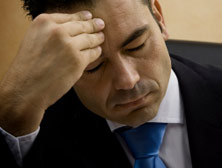MigraineHelper.com
 |
 |
 |
 |
|
Acupuncture and Migraine TreatmentMigraines are chronic and often severely painful headaches. They're different from an average headache in the severity and the symptoms. Some symptoms of a migraine include sensitivity to sound or light, nausea and vomiting, light flashes behind the eyes, or a tingling sensation in the arms or legs. The cause of migraines is a bit of a mystery but it has been associated with allergic reactions and low magnesium levels. There are numerous triggers including physical exertion, stress, some types of foods and stress. Medication can be used to treat the severity of the attack and the frequency. Sometimes alternative therapies like acupuncture work to help or alleviate the attacks. What Does It Involve?Acupuncture involves inserting fine needles into various points in the body. The patient lies down in a quiet, warm room. The acupuncturist inserts fine stainless steel needles into various places in the body depending on the problem. The needles vary in length from 0.51 inches to 5.1 inches and are 0.16 millimeters to 0.46 millimeters thick. The finer and shorter needles are the ones used near the face and eyes and would likely be the ones most often used to treat migraine pain. The tips of the needles are extremely sharp so they can be inserted into the body without pain. Sometimes a mild electrical current is applied to the needles. Origins of AcupunctureAcupuncture has been practiced by many different cultures for more than 5,000 years. Even though it's mostly connected with traditional Chinese practices, South African Bantu tribesmen, Arabs and the Inuit have also used this treatment throughout history. Around 200 BC the Chinese wrote an ancient medical text called "Huangdi Neijing" which described acupuncture as a medical treatment. Traditional Chinese AcupunctureTraditional Chinese acupuncture is based on the philosophy that every person has life energy, or qi, that should flow freely in the body. Qi can be blocked when the two opposed forces or yin and yang are imbalanced. When qi is blocked, the person will experience pain or illness. Acupuncture works to remove those qi blocks and once again create a balance of yin and yang by stimulating specific points in the channels (meridians) that qi flows through the body. In the Western WorldIn the western world acupuncture doesn't have the spiritual significance it has in traditional Chinese treatments. Medical practitioners don't know for sure how it works, but they believe that inserting the ultra fine needles into specific points in the body stimulates the central nervous system. When the central nervous system is stimulated, it releases biochemicals (neurotransmitters and hormones) that help regulate body functions, strengthen the immune system, ease pain and regulate body functions. Its Effectiveness on MigrainesThere are conflicted reports about the effectiveness of acupuncture for treating migraines. The Journal of Traditional Medicine published an Italian study in 200 that said acupuncture provided more significant migraine relief than medications. In 2006 the Journal of Internal Medicine published a different study which basically said acupuncture provided a placebo effect and did nothing for the treatment of migraines.
|
n |